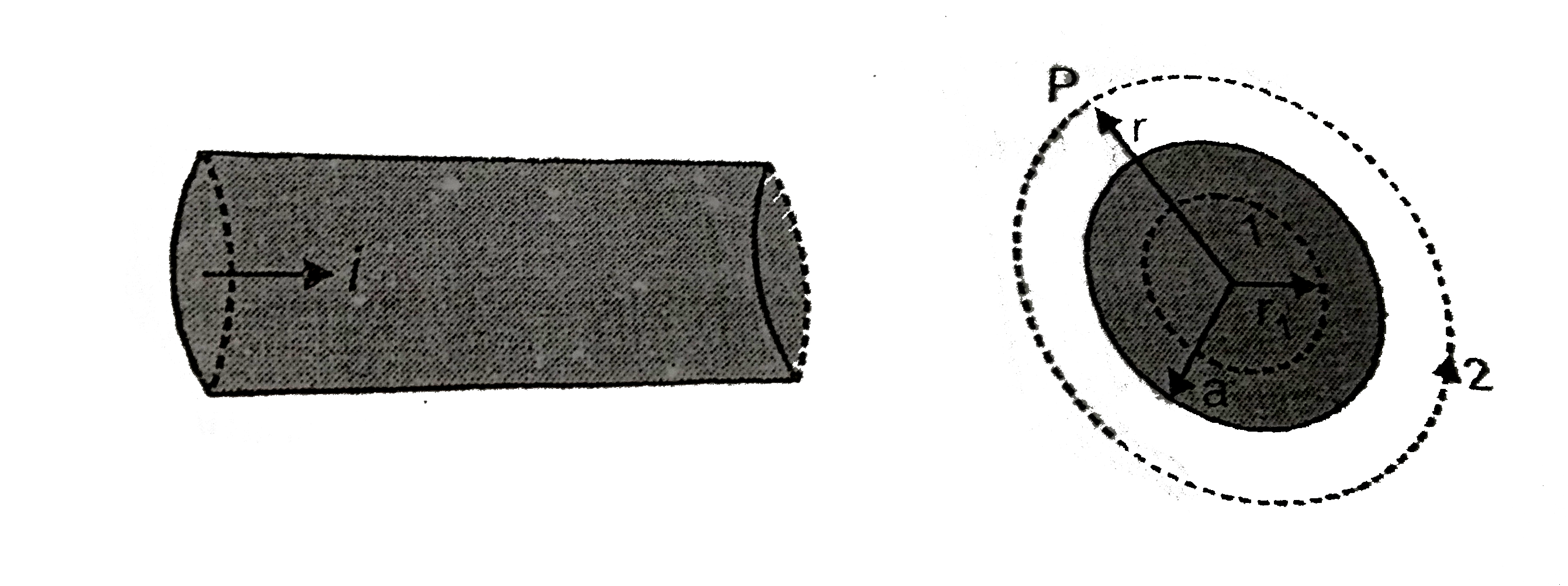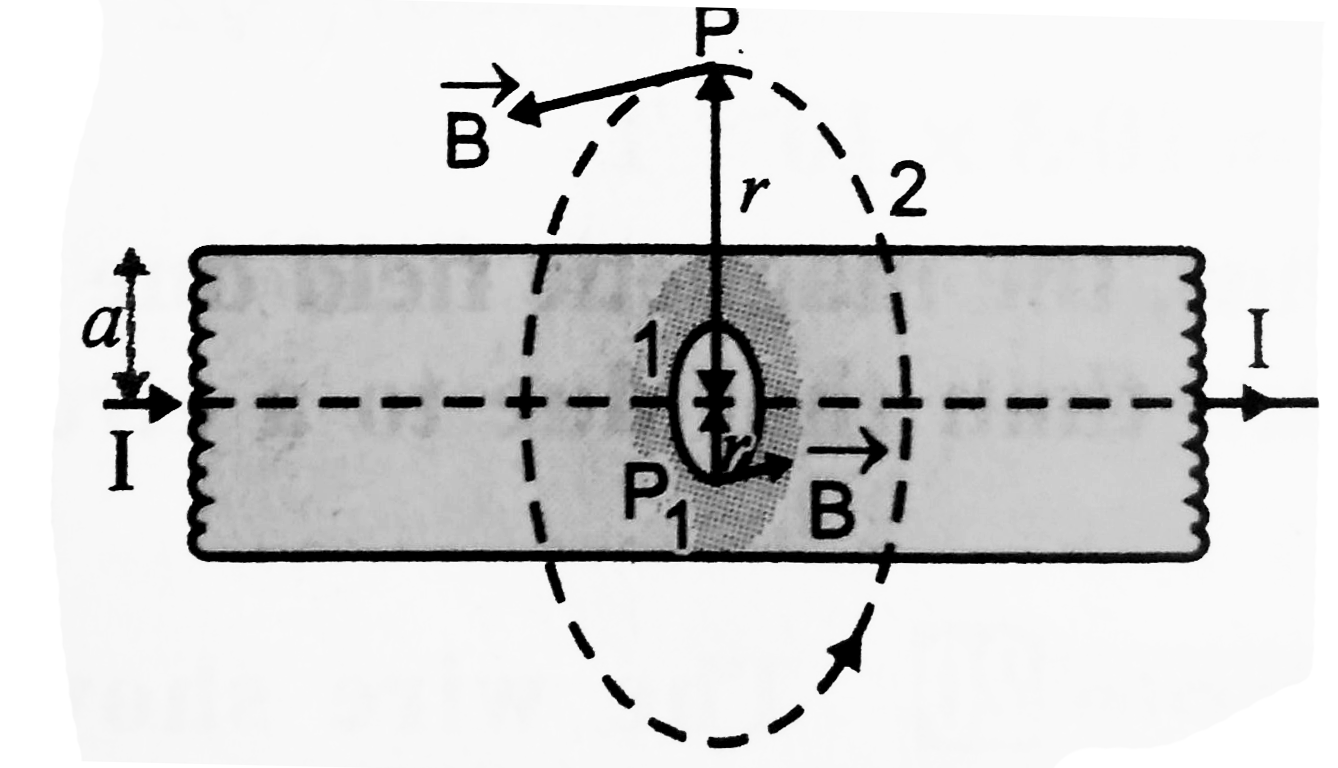A uniform current I is flowing in a long wire of radius R. If the current is uniformly distributed across the cross-sectional area of the wire, then
magnetic field increases linearly from centre to surface
magnetic field decays inversely with distance r from the centre of wire for r>R
magnetic field at the centre of wire is zero
None of the above
To solve the problem regarding the magnetic field due to a uniform current flowing in a long wire of radius R, we can follow these steps:
Step 1: Understand the Problem
We have a long cylindrical wire with radius R carrying a uniform current I. The current is uniformly distributed across the cross-sectional area of the wire. We need to analyze the magnetic field both inside and outside the wire.
Step 2: Apply Ampere's Circuital Law
Ampere's Circuital Law states that the line integral of the magnetic field B around a closed loop is equal to the permeability of free space μ0 times the total current Ienc enclosed by the loop:
∮B⋅dl=μ0Ienc
Step 3: Determine the Magnetic Field Inside the Wire
1. Consider a circular path of radius r (where r<R) inside the wire.
2. The current enclosed Ienc can be calculated based on the area ratio:
Ienc=I⋅Area of smaller circleArea of wire=I⋅πr2πR2=I⋅r2R2
3. The line integral ∮B⋅dl simplifies to:
B⋅(2πr)=μ0Ienc=μ0I⋅r2R2
4. Therefore, we can express B:
B=μ0I2πR2r
This shows that the magnetic field inside the wire increases linearly with r.
Step 4: Determine the Magnetic Field Outside the Wire
1. For a point outside the wire (where r>R), the entire current I is enclosed.
2. The line integral becomes:
B⋅(2πr)=μ0I
3. Thus, the magnetic field B outside the wire is:
B=μ0I2πr
This indicates that the magnetic field outside the wire decreases inversely with r.
Step 5: Summary of Results
- Inside the wire (r<R): B is directly proportional to r and given by B=μ0I2πR2r.
- Outside the wire (r>R): B is inversely proportional to r and given by B=μ0I2πr.
- At the center of the wire (r=0), the magnetic field B=0.
Conclusion
From the analysis, we conclude that:
- The magnetic field inside the wire increases linearly with the distance from the center.
- The magnetic field outside the wire decreases inversely with the distance from the center.
- The magnetic field at the center of the wire is zero.
We have a long cylindrical wire with radius R carrying a uniform current I. The current is uniformly distributed across the cross-sectional area of the wire. We need to analyze the magnetic field both inside and outside the wire.
Ampere's Circuital Law states that the line integral of the magnetic field B around a closed loop is equal to the permeability of free space μ0 times the total current Ienc enclosed by the loop:
∮B⋅dl=μ0Ienc
1. Consider a circular path of radius r (where r<R) inside the wire.
2. The current enclosed Ienc can be calculated based on the area ratio:
Ienc=I⋅Area of smaller circleArea of wire=I⋅πr2πR2=I⋅r2R2
3. The line integral ∮B⋅dl simplifies to:
B⋅(2πr)=μ0Ienc=μ0I⋅r2R2
4. Therefore, we can express B:
B=μ0I2πR2r
This shows that the magnetic field inside the wire increases linearly with r.
1. For a point outside the wire (where r>R), the entire current I is enclosed.
2. The line integral becomes:
B⋅(2πr)=μ0I
3. Thus, the magnetic field B outside the wire is:
B=μ0I2πr
This indicates that the magnetic field outside the wire decreases inversely with r.
- Inside the wire (r<R): B is directly proportional to r and given by B=μ0I2πR2r.
- Outside the wire (r>R): B is inversely proportional to r and given by B=μ0I2πr.
- At the center of the wire (r=0), the magnetic field B=0.
From the analysis, we conclude that:
- The magnetic field inside the wire increases linearly with the distance from the center.
- The magnetic field outside the wire decreases inversely with the distance from the center.
- The magnetic field at the center of the wire is zero.
Similar Questions
A cylindrical long wire of radius R carries a current I uniformly distributed over the cross sectional area of the wire. The magnetic field at a distance x from the surface inside the wire is
View SolutionA long wire in the shape of a cylindrical shell of inner and outer radii R2 and R respectively carries a steady current I in a direction parallel to its length. This current is uniformly distributed across the area of cross-section of the wire. The magnetic field intensity at a point at a distance 3R4 from the axis of the wire is m(μ0IπR).. The value of m is _________.
View SolutionA long thick conducting cylinder of radius 'R' carries a current uniformly distributed over its cross section :
View SolutionA long straight conducting solid cylindrical wire of radius R carries a steady current / that is uniformly distributed throughout the cross section of the wire. Draw graph of magnetic field B versus r (where r is distance from the axis of the wire)
View SolutionA long straight wire of radius a carries a steady current i. The current is uniformly distributed across its cross section. The ratio of the magnetis field at (a)/(2)and(2a) is
View SolutionFigure shows a long straight wire of a circular cross-section (radius a) carrying steady current l. The current l is uniformly distributed across this cross-section. Calculate the magnetic field in the region r<aandr>a

View SolutionCurves in the graph shown in Fig. give, as function of radius distance r, the magnitude B of the magnetic field inside and outside four long wire a,b,c and d, carrying currents that are uniformly distributed across the cross sections of the wires. Overlapping portions of the plots are indicated by double labels.

The current density in wire a is
View SolutionFigure shows a long straight wire of circular crosssection (radius a) carrying steady current I. The current I is uniformly distributed across this crosssection. Calculate the magnetic field in the region r<a and r>a.

View SolutionCurves in the graph shown in Fig. give, as function of radius distance r, the magnitude B of the magnetic field inside and outside four long wire a,b,c and d, carrying currents that are uniformly distributed across the cross sections of the wires. Overlapping portions of the plots are indicated by double labels.

Which wire has the greatest radius?
View SolutionCurves in the graph shown in Fig. give, as function of radius distance r, the magnitude B of the magnetic field inside and outside four long wire a,b,c and d, carrying currents that are uniformly distributed across the cross sections of the wires. Overlapping portions of the plots are indicated by double labels.

Which wire has the greatest radius?
View Solution
